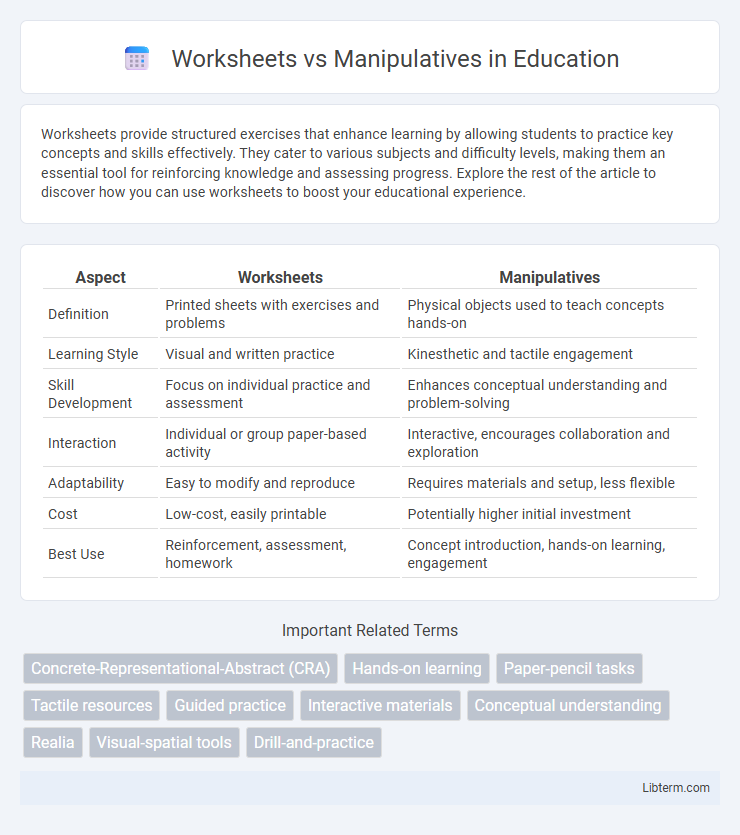Worksheets provide structured exercises that enhance learning by allowing students to practice key concepts and skills effectively. They cater to various subjects and difficulty levels, making them an essential tool for reinforcing knowledge and assessing progress. Explore the rest of the article to discover how you can use worksheets to boost your educational experience.
Table of Comparison
| Aspect | Worksheets | Manipulatives |
|---|---|---|
| Definition | Printed sheets with exercises and problems | Physical objects used to teach concepts hands-on |
| Learning Style | Visual and written practice | Kinesthetic and tactile engagement |
| Skill Development | Focus on individual practice and assessment | Enhances conceptual understanding and problem-solving |
| Interaction | Individual or group paper-based activity | Interactive, encourages collaboration and exploration |
| Adaptability | Easy to modify and reproduce | Requires materials and setup, less flexible |
| Cost | Low-cost, easily printable | Potentially higher initial investment |
| Best Use | Reinforcement, assessment, homework | Concept introduction, hands-on learning, engagement |
Understanding Worksheets and Manipulatives
Worksheets provide structured exercises designed to reinforce specific skills and concepts, allowing for individual practice and assessment. Manipulatives offer tactile, hands-on experiences that foster deeper conceptual understanding through interactive learning and exploration. Both tools complement each other by combining abstract problem-solving with concrete, sensory engagement to enhance comprehension and retention.
Defining Key Differences
Worksheets provide structured, written problems designed to reinforce concepts through practice, while manipulatives offer hands-on, tactile tools that promote active learning and conceptual understanding. Worksheets primarily support individual, paper-based tasks to develop procedural skills, whereas manipulatives encourage exploration and collaboration, enhancing spatial reasoning. The key difference lies in engagement methods: worksheets emphasize cognitive practice, and manipulatives foster kinesthetic interaction with educational content.
Cognitive Benefits of Worksheets
Worksheets enhance cognitive skills by promoting active learning through structured practice and problem-solving exercises, which improve memory retention and critical thinking abilities. They enable learners to organize information logically, facilitating better understanding and retrieval of knowledge. The repetitive nature of worksheets also reinforces neural connections, supporting long-term cognitive development in academic subjects such as math and language arts.
Cognitive Benefits of Manipulatives
Manipulatives enhance cognitive development by providing hands-on learning experiences that improve spatial reasoning, problem-solving skills, and conceptual understanding. Unlike worksheets, manipulatives engage multiple senses, fostering deeper memory retention and active learning processes. These tangible tools support abstract thinking by allowing students to physically explore mathematical and scientific concepts, leading to improved critical thinking and analytical abilities.
Engagement and Motivation Levels
Worksheets provide structured practice that can reinforce concepts through repetition, but they may lead to lower engagement and motivation due to their passive nature. Manipulatives, such as physical objects or interactive tools, increase student engagement by offering hands-on learning experiences that stimulate curiosity and enhance understanding. Studies show that learners using manipulatives demonstrate higher motivation levels and improved retention compared to those relying solely on worksheets.
Adaptability for Diverse Learners
Worksheets offer structured practice that can be easily modified to cater to different skill levels, providing clear guidance for visual and independent learners. Manipulatives deliver tactile and kinesthetic experiences, promoting engagement and conceptual understanding for students who benefit from hands-on learning. Combining both tools allows educators to create adaptable lessons that address a wide range of learning preferences and developmental needs.
Real-World Application of Concepts
Worksheets provide structured practice that reinforces theoretical understanding of math concepts, while manipulatives offer hands-on experiences that connect abstract ideas to real-world situations. Using manipulatives like fraction tiles or geometric solids enables learners to visualize and physically interact with concepts, fostering deeper comprehension and practical application. Combining both tools enhances problem-solving skills by linking symbolic representation with tangible examples encountered in everyday life.
Cost and Accessibility Considerations
Worksheets generally offer a low-cost and highly accessible option for educators and parents, requiring minimal resources beyond paper and printing. Manipulatives, while often more engaging and hands-on, can be expensive to purchase or create and may present logistical challenges for widespread distribution or use in remote learning settings. Cost-effectiveness and ease of access remain critical factors when selecting between worksheets and manipulatives for educational purposes.
Teacher Perspectives and Preferences
Teachers often view worksheets as efficient tools for reinforcing concepts and assessing individual student understanding due to their structured format and ease of distribution. In contrast, manipulatives are preferred for promoting hands-on learning and conceptual comprehension, particularly in subjects like math, where tactile engagement supports abstract thinking. Educators tend to balance these resources based on lesson objectives, student learning styles, and classroom management considerations.
Striking the Right Balance in Classrooms
Worksheets provide structured practice to reinforce foundational skills, while manipulatives offer hands-on, tactile learning that enhances conceptual understanding in classrooms. Striking the right balance involves integrating both methods to cater to diverse learning styles and promote engagement alongside skill mastery. Effective classroom strategies combine worksheets for skill assessment with manipulatives to foster critical thinking and deeper comprehension.
Worksheets Infographic

 libterm.com
libterm.com